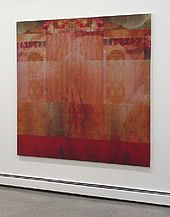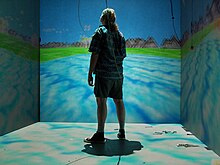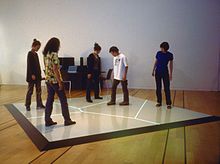Digital art
This article has multiple issues. Please help improve it or discuss these issues on the talk page. (Learn how and when to remove these messages)
|



Digital art can either be understood as any artistic work or practice that uses digital technology as part of the creative or presentation process, or more specifically as computational art that uses and engages with digital media.[1]
Since the 1960s, various names have been used to describe digital art, including computer art, multimedia art[2] and new media art.[3][4]
History
After some initial resistance,[5] the impact of digital technology has transformed activities such as painting, literature, drawing, sculpture and music/sound art, while new techniques, such as net art, digital installation art, and virtual reality, have emerged.[6]

Andy Warhol created digital art using a Commodore Amiga where the computer was publicly introduced at the Lincoln Center, New York in July 1985. An image of Debbie Harry was captured in monochrome from a video camera and digitized into a graphics program called ProPaint. Warhol manipulated the image adding colour by using flood fills.[7][8]
Art that uses digital tools
Digital art can be purely computer-generated (such as fractals and algorithmic art) or taken from other sources, such as a scanned photograph or an image drawn using vector graphics software using a mouse or graphics tablet. Artworks are considered digital painting when created in a similar fashion to non-digital paintings but using software on a computer platform and digitally outputting the resulting image as painted on canvas.
Amidst varied opinions on the pros and cons of digital technology on the arts, there seems to be a strong consensus within the digital art community that it has created a "vast expansion of the creative sphere", i.e., that it has greatly broadened the creative opportunities available to professional and non-professional artists alike.[9]
Whilst 2D and 3D digital art is beneficial as it allows preservation of history that would otherwise have been destroyed by events like natural disasters and war, there is the issue of who should own these 3D scans - i.e. who should own the digital copyrights.[10]
Computer-generated visual media

Digital visual art consists of either 2D visual information displayed on an electronic visual display or information mathematically translated into 3D information, viewed through perspective projection on an electronic visual display. The simplest is 2D computer graphics which reflect how you might draw using a pencil and a piece of paper. In this case, however, the image is on the computer screen and the instrument you draw with might be a tablet stylus or a mouse. What is generated on your screen might appear to be drawn with a pencil, pen or paintbrush. The second kind is 3D computer graphics, where the screen becomes a window into a virtual environment, where you arrange objects to be "photographed" by the computer. Typically a 2D computer graphics use raster graphics as their primary means of source data representations, whereas 3D computer graphics use vector graphics in the creation of immersive virtual reality installations. A possible third paradigm is to generate art in 2D or 3D entirely through the execution of algorithms coded into computer programs. This can be considered the native art form of the computer, and an introduction to the history of which is available in an interview with computer art pioneer Frieder Nake.[11] Fractal art, Datamoshing, algorithmic art and real-time generative art are examples.
Computer generated 3D still imagery
3D graphics are created via the process of designing imagery from geometric shapes, polygons or NURBS curves[12] to create three-dimensional objects and scenes for use in various media such as film, television, print, rapid prototyping, games/simulations and special visual effects.
There are many software programs for doing this. The technology can enable collaboration, lending itself to sharing and augmenting by a creative effort similar to the open source movement, and the creative commons in which users can collaborate in a project to create art.[13]
Pop surrealist artist Ray Caesar works in Maya (a 3D modeling software used for digital animation), using it to create his figures as well as the virtual realms in which they exist.
Computer generated animated imagery
Computer-generated animations are animations created with a computer, from digital models created by the 3D artists or procedurally generated. The term is usually applied to works created entirely with a computer. Movies make heavy use of computer-generated graphics; they are called computer-generated imagery (CGI) in the film industry. In the 1990s, and early 2000s CGI advanced enough so that for the first time it was possible to create realistic 3D computer animation, although films had been using extensive computer images since the mid-70s. A number of modern films have been noted for their heavy use of photo realistic CGI.[14]
Art made for digital media
In contemporary art, the term digital art is used primarily to describe visual art that is not just made with digital tools, but that is highly computational and explicitly engages with digital technologies. Art historian Christiane Paul writes that it "is highly problematic to classify all art that makes use of digital technologies somewhere in its production and dissemination process as digital art, since it makes it almost impossible to arrive at any unifying statement about the art form".[15]
Digital installation art

Digital installation art constitutes a broad field of activity and incorporates many forms. Some resemble video installations, particularly large scale works involving projections and live video capture. By using projection techniques that enhance an audience's impression of sensory envelopment, many digital installations attempt to create immersive environments. Others go even further and attempt to facilitate a complete immersion in virtual realms. This type of installation is generally site-specific, scalable, and without fixed dimensionality, meaning it can be reconfigured to accommodate different presentation spaces.[17]
Noah Wardrip-Fruin's "Screen" (2003) is an example of interactive digital installation art which makes use of a Cave Automatic Virtual Environment to create an interactive experience.[18] Scott Snibbe's "Boundary Functions" is an example of augmented reality digital installation art, which responds to people who enter the installation by drawing lines between people indicating their personal space.[16]
Digital art and blockchain
Blockchain, and more specifically NFTs, have been associated with digital art since the NFTs craze of 2020 and 2021. While the technology received many critics and has many flaws related to plagiarism and fraud (due to its almost completely unregulated nature),[19] auction houses like Sotheby's, Christie's and various museums and galleries in the world started collaborations and partnerships with digital artists, selling NFTs associated with digital artworks (via NFT platforms) and showcasing those artworks (associated to the respective NFTs) both in virtual galleries and real life screens, monitors and TVs.[20][21]
Art theorists and historians
Notable art theorists and historians in this field include Oliver Grau, Jon Ippolito, Christiane Paul, Frank Popper, Jasia Reichardt, Mario Costa, Christine Buci-Glucksmann, Dominique Moulon, Robert C. Morgan, Roy Ascott, Catherine Perret, Margot Lovejoy, Edmond Couchot, Fred Forest and Edward A. Shanken.
Scholarship and archives
In addition to the creation of original art, research methods that utilize AI have been generated to quantitatively analyze digital art collections. This has been made possible due to large-scale digitization of artwork in the past few decades. Although the main goal of digitization was to allow for accessibility and exploration of these collections, the use of AI in analyzing them has brought about new research perspectives.[22]
Two computational methods, close reading and distant viewing, are the typical approaches used to analyze digitized art.[23] Close reading focuses on specific visual aspects of one piece. Some tasks performed by machines in close reading methods include computational artist authentication and analysis of brushstrokes or texture properties. In contrast, through distant viewing methods, the similarity across an entire collection for a specific feature can be statistically visualized. Common tasks relating to this method include automatic classification, object detection, multimodal tasks, knowledge discovery in art history, and computational aesthetics.[22] Whereas distant viewing includes the analysis of large collections, close reading involves one piece of artwork.
Subtypes
- Art game
- ASCII art
- Chip art
- Computer art scene
- Computer music
- Crypto art
- Cyberarts
- Digital illustration
- Digital imaging
- Digital literature
- Digital painting
- Digital photography
- Digital poetry
- Digital sculpture
- Digital architecture
- Dynamic Painting
- Electronic music
- Evolutionary art
- Fractal art
- Generative art
- Generative music
- GIF art
- Immersion (virtual reality)
- Interactive art
- Internet art
- Motion graphics
- Music visualization
- Photo manipulation
- Pixel art
- Render art
- Software art
- Systems art
- Textures
Related organizations and conferences
- Artfutura
- Artmedia
- Austin Museum of Digital Art
- Computer Arts Society
- EVA Conferences
- Los Angeles Center for Digital Art
- Lumen Prize
- onedotzero
- Rhizome
- V&A Digital Futures
See also
- Algorithmic art
- Computer art
- Computer graphics
- Electronic art
- Generative art
- Graphic arts
- New media art
- Theatre of Digital Art
- Virtual art
References
- ^ Paul, Christiane (2016). "Introduction From Digital to Post‐Digital—Evolutions of an Art Form". In Paul, Christiane (ed.). A Companion to Digital Art. Malden, MA: Wiley. pp. 1–2. ISBN 978-1-118-47520-1.
- ^ Reichardt, Jasia (1974). "Twenty years of symbiosis between art and science". Art and Science. XXIV (1): 41–53.
- ^ Christiane Paul (2006). Digital Art, pp. 7–8. Thames & Hudson.
- ^ Lieser, Wolf. Digital Art. Langenscheidt: h.f. ullmann. 2009, pp. 13–15
- ^ Taylor, G. D. (2012). The soulless usurper: Reception and criticism of early computer art. In H. Higgins, & D. Kahn (Eds.), Mainframe experimentalism: Early digital computing in the experimental arts. Berkeley, CA: University of California Press
- ^ Donald Kuspit The Matrix of Sensations VI: Digital Artists and the New Creative Renaissance
- ^ 'Reimer, Jeremy (October 21, 2007). "A history of the Amiga, part 4: Enter Commodore". Arstechnica.com. Retrieved June 10, 2011.
- ^ YouTube. Archived from the original on 2009-05-07.
- ^ Bessette, Juliette; Frederic Fol Leymarie; Glenn W. Smith (16 September 2019). "Trends and Anti-Trends in Techno-Art Scholarship: The Legacy of the Arts "Machine" Special Issues". Arts. 8 (3): 120. doi:10.3390/arts8030120.
- ^ Sydell, Laura (21 May 2018). "3D Scans Help Preserve History, But Who Should Own Them? 2018". NPR. Archived from the original on 2022-01-18. Retrieved 7 February 2021.
- ^ Smith, Glenn (31 May 2019). "An Interview with Frieder Nake". Arts. 8 (2): 69. doi:10.3390/arts8020069.
- ^ Wands, Bruce (2006). Art of the Digital Age, pp. 15–16. Thames & Hudson.
- ^ Foundation, Blender. "About". blender.org. Retrieved 2021-02-25.
- ^ Lev Manovich (2001) The Language of New Media Cambridge, Massachusetts: The MIT Press.
- ^ Christiane Paul, ed. (2016). A companion to digital art. Chichester, West Sussex: Wiley. pp. 1–2. ISBN 978-1-118-47521-8. OCLC 925426732.
- ^ a b "Boundary Functions"
- ^ Paul, Christiane (2006). Digital Art, pp 71. Thames & Hudson.
- ^ "screen - noah wardrip-fruin".
- ^ "Does NFT Art Have A Place In The Museum In 2022?". jingculturecommerce.com. 6 January 2022.
- ^ "Natively Digital: A Curated NFT Sale". sothebys.com.
- ^ "Beeple sold an NFT for $69 million". theverge.com. 11 March 2021.
- ^ a b Cetinic, Eva; She, James (2022-02-16). "Understanding and Creating Art with AI: Review and Outlook". ACM Transactions on Multimedia Computing, Communications, and Applications. 18 (2): 66:1–66:22. arXiv:2102.09109. doi:10.1145/3475799. ISSN 1551-6857. S2CID 231951381.
- ^ Lang, Sabine; Ommer, Bjorn (2018). "Reflecting on How Artworks Are Processed and Analyzed by Computer Vision: Supplementary Material". Proceedings of the European Conference on Computer Vision (ECCV) Workshops – via Computer Vision Foundation.
External links
 Media related to Digital art at Wikimedia Commons
Media related to Digital art at Wikimedia Commons- Dreher, Thomas. "History of Computer Art"
- Zorich, Diane M. "Transitioning to a Digital World"
